Spring 2024
Participatory Community Arts Project – Salmon’s Journey through Mill Creek
This Web-based digital interactive simulates what it is like to be a Spring Chinook Salmon swimming upstream through Mill Creek in the City of Walla Walla WA. This work-in-progress draws on the expertise of local conservation experts and the art created by local young people. More original children’s art will be uploaded into the next release. The app allows the player to adjust animated water effects that may cause issues to some. Future accessible options will include voiced prompts, alternative player input modes, and choice of language. Click this link to try the simulation in your Web Browser.
Publication
Book Chapter Graphics + Accessibility
This chapter provides an introduction to computer graphics concepts related to accessibility. I’m most excited about the blend of hands-on tangible activities and programming activities for instructors. This chapter appears in the 1st edition of the Teaching Accessible Computing online book. Edited by Alannah Oleson, Amy J. Ko, Richard Ladner (2024).
Spring 2023
Publication
Haptics for Accessible Graphics in CS1
William Bares and CS colleague Jordan Wirfs-Brock collaborated on this research paper that demonstrates a way to teach accessibility using haptics after CS1 students have learned the basics of objects and Turtle graphics. The paper has been accepted to appear in the SIGGRAPH 2023 Educator’s Forum. Students added haptic feedback commands to signal which way to turn to guide a person to navigate along with the Python Turtle drawing (middle). Haptic feedback communicates information from a data visualization (right).
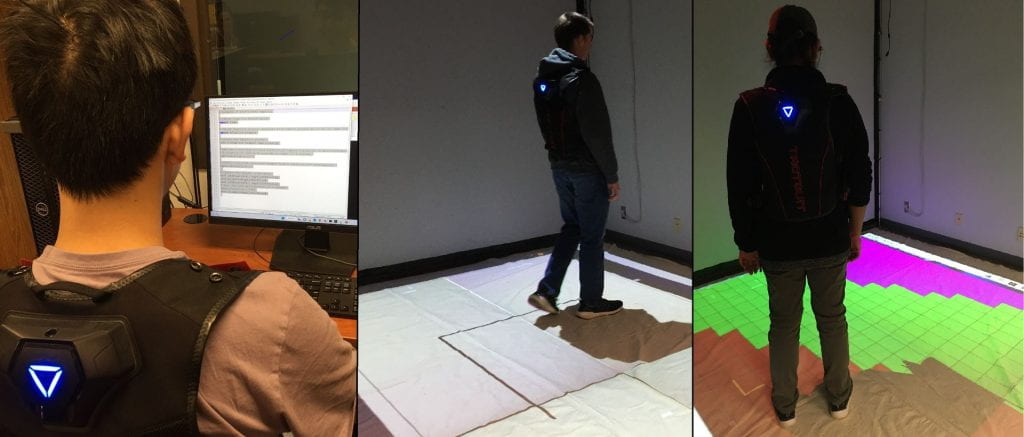
Create Python programs that use haptic vest feedback to navigate a Turtle drawing and explore a data visualization.
Senior Art Project
Kangerlussauq by Abby Morandi
The Immersive Stories Lab helped Abby to prototype an immersive projection and loaned an ultra-short throw laser projector for the installation in the Sheehan Gallery. Click this link to read Abby’s artist statement and view more images of the installation.
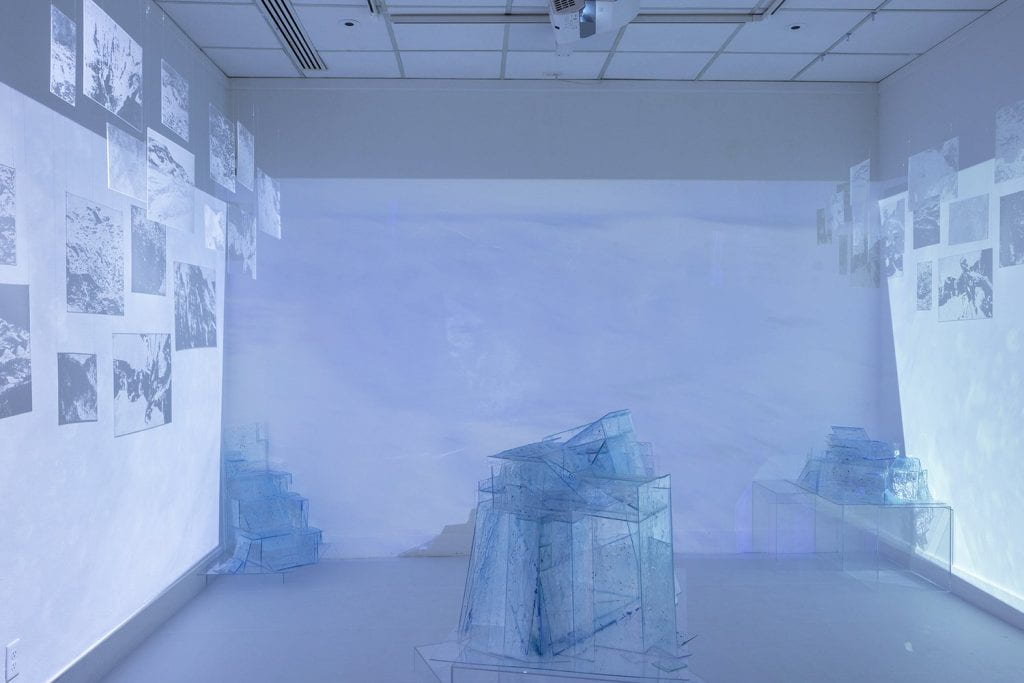
Kangerlussauq – photograph by Tara Graves of the Sheehan Art Gallery
Computer Science Capstone
Virtual Mojave Desert
Seniors Nick Hager (pictured below), Ahmed Elsayed, Ben Grabau, and Jasper Kim worked in the lab supervised by capstone instructor John Stratton to develop a virtual geology lab activity set in the Mojave Desert. Geology professor Lyman Persico and his team used a drone to digitize a terrain elevation map.
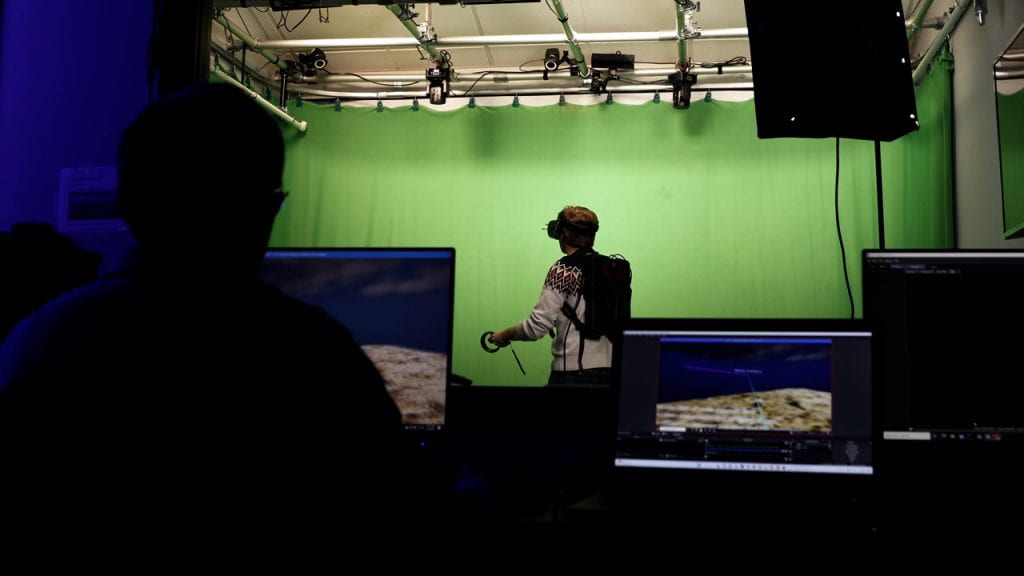
Virtual Reality (VR) Computer Science senior capstone project explores virtual Mojave desert dataset from professor Lyman Persico.
In this video example, a student uses the VR hand controllers to measure a difference in terrain elevation. Students use a virtual teleport effect to move between signposts whose text gives the lab instructions.
Teaching Collaboration
Hispanic Studies
Students in Mariana Perez’s Hispanic Studies class imagine Picasso’s Guernica in the time of COVID cleaning precautions. Students used the Web previs app to plan their immersive projection imagery before they came to the lab in costume to photograph their scenes.
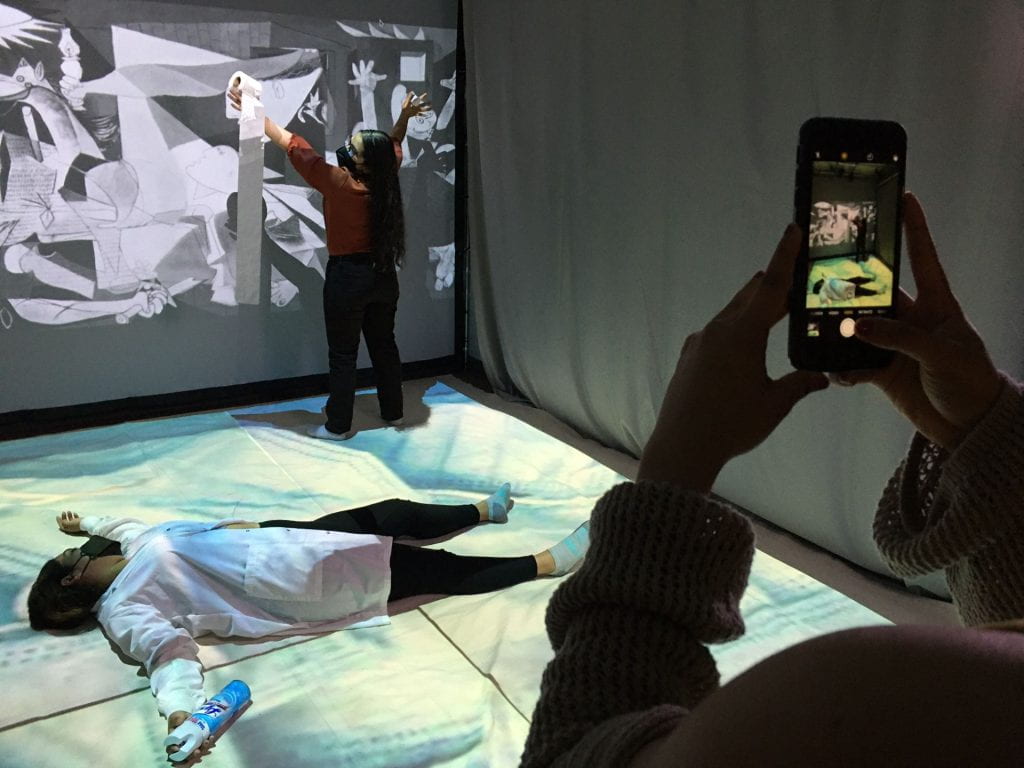
Students in Mariana Perez’s Hispanic Studies class imagine Picasso’s Guernica in the time of COVID cleaning precautions.
Fall 2022
Software App Released and Teaching Collaboration
Storytelling in FYS GENS 175
First-year students in the Storytelling pod were invited to dramatize story scenes by applying projection, color, and lighting to impart mood and tone. Students applied concepts taught by Theater professor Dan Schindler for how to use color and mood boards to communicate emotional tones. William Bares created a 3D Web app that lets anyone previsualize ideas for immersive projections. Upload images to simulate the lab’s background and floor projections and color studio lights. Change the virtual camera angle and pose the articulated stick figures. Click here to check it out!
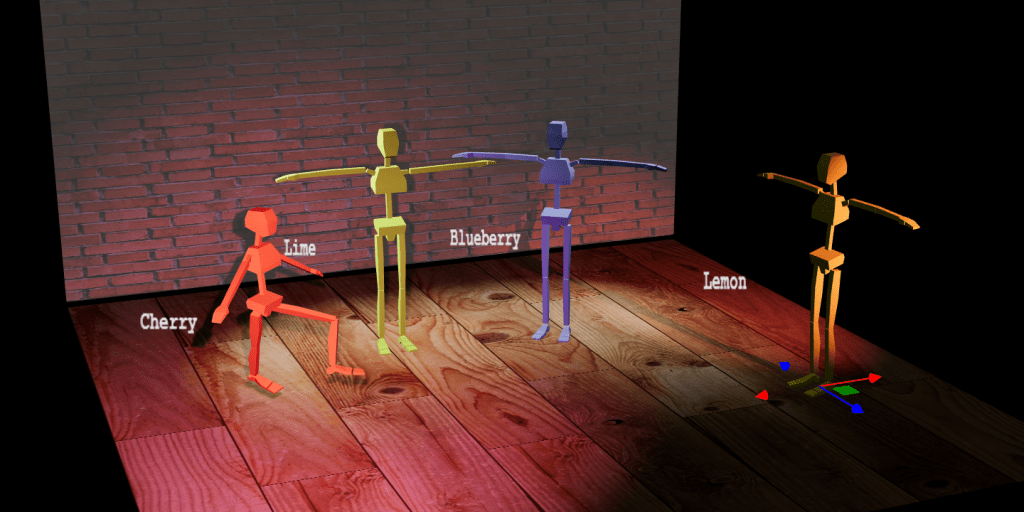
Sample Scene Created by the Web Previs App
Teaching Collaboration
Immersive Spatial Audio Dance Project
Students in Dan Schindler and Peter de Grasse’s respective Theater and Dance classes combined to produce a final class project featuring immersive projections and directional sound.
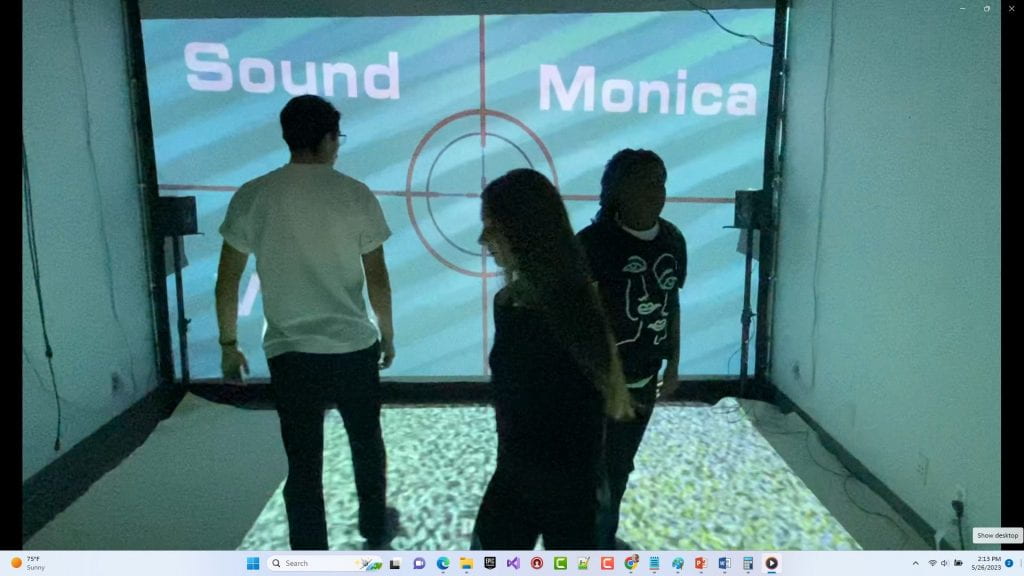
Students in Dan Schindler and Peter de Grasse’s respective Theater and Dance classes combined to produce a final class project featuring immersive projections and directional sound.
News Article
The Whitman Magazine published an article about William Bares and the Immersive Stories Lab. Click this link to access the article.
Spring 2022
Senior Art Project
Aphros by Morgan Greaton
The lab supported senior art student (now alumna) Morgan Greaton’s immersive three wall video projection project by loaning our ultra-short throw laser projectors to the Sheehan Art Gallery. Morgan describes her work: My art is rooted in the deep, porous and interconnected nature of all living things. The soil, the trees, the rivers, the ocean, and the sky speak a language of their own, one that resides deep in the memory of every being. In perceiving my body as a vessel for an intuitive and primordial creative force, I seek to co-create with the natural world and to bring to life their spirit through sensorial experiences.

Aphros by Morgan Greaton
Teaching Collaboration
Harold and the Purple Crayon
Senior art student (now alumna) Eva Coulon incorporated motion tracking, immersive projection, and natural-language text generation to create an interactive experience inspired by the classic children’s book. The position of a tracked marker painted purple trails and warped the floor-projected text of the story using Touch Designer. The lab hosted the final project presentations of Justin Lincoln’s New Media Art class. Eva learned how to use motion tracking data in the Intelligent User Interfaces CS special topics class.
Publication
Stage Together: Remote Rehearsal of Theater Blocking
Developed a collaborative, Web app to support remote rehearsal of theater blocking. Optional floor-projected blocking increased the sense of immersion. This work was done in collaboration with Dr. Anna Conser’s Classic Department’s production of Medea by Euripides. In Proceedings of the 8th International Conference on Movement and Computing (MOCO ’22). Association for Computing Machinery, New York, NY, USA, Article 2, 1–5. https://doi.org/10.1145/3537972.3537977
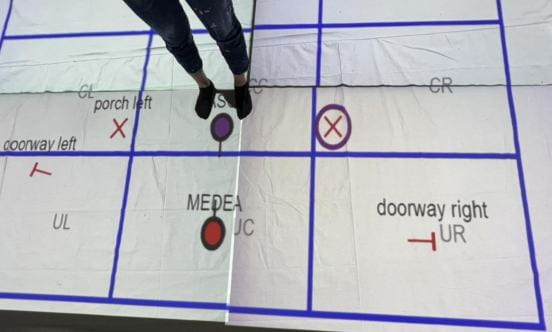
Floor-projected blocking map
Publication
Motion-Sensor Programming for Accessible Interfaces
Teaching eye-tracking and motion-tracking programming for building accessible user interfaces. In Proceedings of the 8th International Conference on Movement and Computing (MOCO ’22). Association for Computing Machinery, New York, NY, USA, Article 26, 1–5. https://doi.org/10.1145/3537972.3538006
Fall 2021
Grant Awarded
TeachAccess – Accessible Motion Programming
TeachAccess awarded funds to develop teaching materials for programming accessible user interfaces using eye tracking and motion tracking. Funding supported undergraduate student Abdelrahman Elawadly in Summer 2022.
Highlights of Intelligent User Interfaces Fall 2021 Final Projects
Story of how this lab was started during the COVID year of 2020